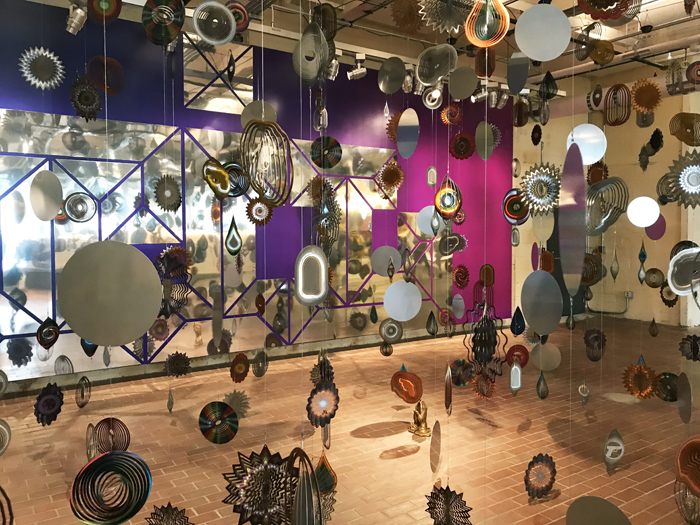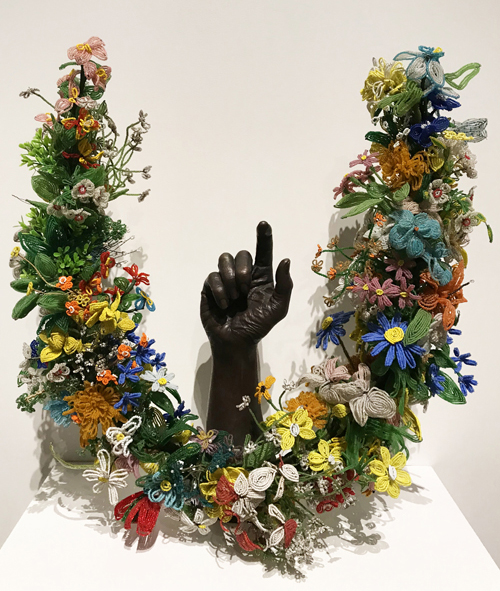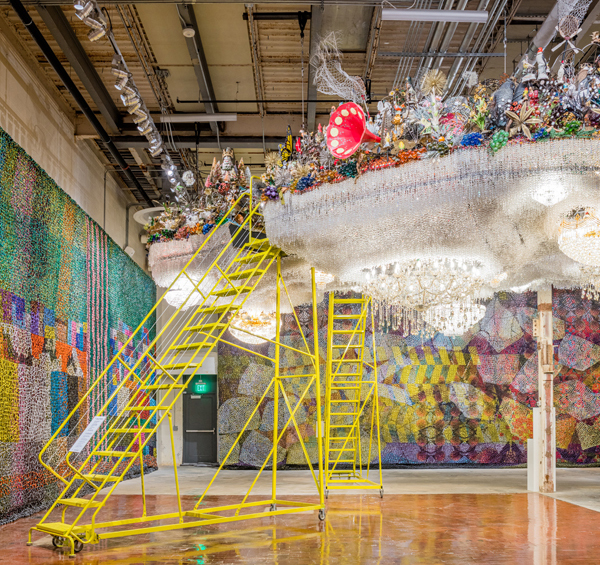Nick Cave at The Momentary
Colette Copeland
December 2020
Up until
Not until
Pray until
the cows come home.They can’t kill us,
Until they kill us.Wait until dark,
then squeeze until
the pipes squeak.Until blue in the face,
I will scream.Until my voice is gone,
I will scream.Until I bleed out,
I will scream.Until the light takes us,
I will gleam.Until the wrath be past,
I will fight the regime.Until the end of all hours,
I will fight for esteem.Until the end of the world,
I will dream.
– Colette Copeland
 Kinetic Spinner, Nick Cave, image courtesy of the author
Kinetic Spinner, Nick Cave, image courtesy of the author
When researching vernacular phrases containing the word until, I was surprised to discover that so many of the sayings reference death and dying. Nick Cave’s usage of the exhibition title references the phrase “innocent until proven guilty” or more aptly in the case of American black men and women in the U.S. justice system, “guilty until proven innocent.”
Cave’s ambitious exhibition at The Momentary spans 24,000 square feet, addressing issues of gender, race and gun violence. The exhibition is Cave’s personal visual response to the question, “Is there racism in heaven?” The first gallery features a forest of colorful wind ornaments. At first glance, the objects’ kinetic motion is whimsical and a bit disorienting, as if we are walking through a Dr. Seuss tale. Upon closer examination, we see that all is not as it appears on the surface. Embedded in the wind ornaments, we see images of guns, targets and bullets. Indicative of the systematic racism and oppression inherent in our country’s history and present day, Cave’s visual markers reveal the work that needs to be done to create change.
 Hy-Dyve, Nick Cave, image courtesy of the author
Hy-Dyve, Nick Cave, image courtesy of the author
Adjacent to the spinner gallery and the boiler room is the 14-channel video installation Hy-Dyve. The video/sound works cover floor and walls with psychedelic patterns and imagery. Eye balls looking through holes and a black gumby figure caught my attention. The center of the room features an imposing large-scale (floor-ceiling) wooden life guard chair. The object reminds me of a scaffolding with subtle references to a hanging platform. In a previous iteration of this work, the water video projections on the floor were more visible. In this space, if one dove from such a platform, it would be to their death.
The 2nd large gallery contains three bodies of work. At the entrance to the gallery is a poignant memorial to Michael Brown titled Unarmed. The artist’s cast bronze hand/arm is pointing upwards, surrounding by a wreath of beaded flowers. The gesture has become an iconic symbol for the #blm movement. The sculpture references the many deaths of unarmed black people by law enforcement, but I also interpret it as a sign pointing to the heavens–an entry point to the crystal cloud, asking us to look beyond our day-to-day tunnel vision.
 Unarmed, Nick Cave, image courtesy of the author
Unarmed, Nick Cave, image courtesy of the author
Two large three-story beaded cliff walls frame the entrance to the cloud, serving as sentries. Visitors can view the cliff walls from different vantage points on the stairs. Unlike a solid wall, viewers can experience the inside, looking out. I saw Cave’s retrospective of his sound suits in 2018 at the Frist Museum in Nashville. He made his first suit after the Rodney King beating, as a creative, metaphoric response to how he might protect himself against police targeting and violence. The far-reaching and awe-inspiring beaded cliffs expand the notion of the suit as a way to include, rather than exclude a community.
 Crystal Cloudscape from “Nick Cave: Until”, The Momentary,
Crystal Cloudscape from “Nick Cave: Until”, The Momentary,
Bentonville, Arkansas, photo by Ironside Photography
From below, the Crystal Cloudscape looks like an ornate compositing of chandeliers, surrounding by more beaded walls. Four yellow metal ladders frame the sculptural installation allowing viewers a glimpse into Cave’s heaven one at a time, but only if you aren’t scared of heights or wearing heels. It’s worth the climb. The top features a mélange of manufactured found objects including ceramic flowers, animals and plants. Cave includes lawn jockeys holding large nets, recontextualizing them from their former racist history into objects of hope.
As in much of Cave’s work, Until is filled with optical feats of wonder and labor. Thus, it is easy to get visually overwhelmed and miss details. The work requires time and reflection. If the kinetic spinner forest serves as a catalyst to discuss race, white fragility, and injustice, the Crystal Cloudscape presents us with a utopic vision of future possibilities, but only if we (meaning white liberals) are willing to dive deep and do the work. Rather than polemics, Cave adopts the strategical tactics of beauty, absurdity and spectacle, as a conduit for contemplation and dialogue.
The Momentary
September 12, 2020 – January 3, 2021
Bentonville, Arkansas
◊
Colette Copeland is a multimedia artist, art educator, writer and social activist. She has volunteered with Traffick911 for nine years as an advocate and educator, spreading awareness about the sex trafficking of children in the DFW area. Prior to covid, she volunteered teaching dance therapy to incarcerated teens.
